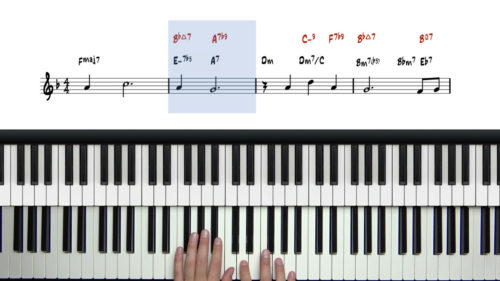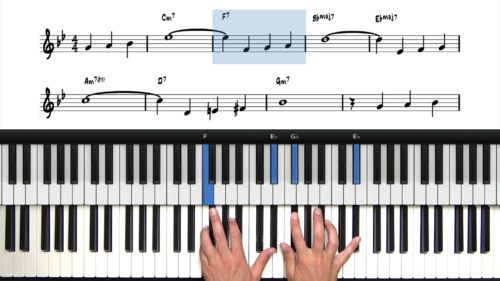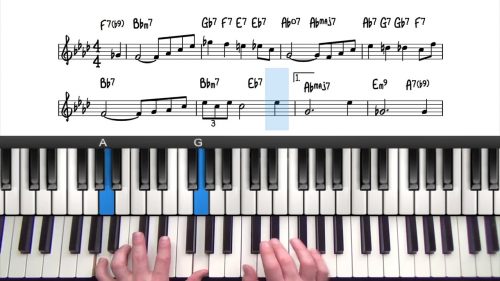The B Section Improvisation
In this lesson we explore improvisation concepts over the bridge of “Misty”. We learn techniques for creating melodies over the minor line cliché, and how to create melodic interest over a single static chord type.
The Bridge Harmony Recap
The entire first line of the B section is effectively a stretched out 251 in Ab Major. We have a minor line cliché in the first 2 bars which indicates a descending moving voice from Bb- to Bb-maj7 to Bb-7 to Eb7.
We then have 2 full bars of Abmaj7. A useful trick here is to walk up to the 3rd degree by playing Abmaj7, Bb-7, Bdim7, C-7 or Ab/C. This adds movement and creates new possibilities from an improvisation standpoint.
Moving onto the 2nd line we can play a full bar of A-7 and then a full bar of D7 or another option is to play A-7 / D7 / C-7 / F7 and then move into the 3625 in the final 2 bars.
The 3625 Progression
The 3625 can be voiced with the diatonic 7th chords, as altered dominants, and we can also use the tritone substitutes to play G-7, Gb7, F-7, E7. In addition we can change those tritone subs to major chords to create an interesting turnaround passage.
For improvising over the 3625 we can use any of the devices that we have previously covered in this module such as targeting chord tones, utilising arpeggios, altered lines and targeting alterations, or chromatic voices and blues scale licks.
Lesson Downloads
-
B Section Improv Notation File Type: pdf
Practice Tips
-
Experiment with block chords when transitioning into the bridge. The ascending melodic motif can be harmonised with George Shearing style 4-way close voicings.
-
When creating melodies over the minor line cliche, bring out the major 7th in your melody lines when the harmony changes to Bb-maj7.
-
Improvise over the walk-up chords using chord tones and chromatic approach patterns. Bluesy ornamentation works well over the Bdim7 chord.
-
Spend some time on chord tone and arpeggio drills for the A-7 to D7 and the C-7 to F7 as we have not covered these chords in A Sections.








Great lesson, thanks Hayden! Now that I can play (almost!) fluently the three or four solos you’ve given as examples, I still find it extremely difficult to mix and match and even more to really improvise on a différent solo. It’s like my mind is stuck on each solo as if it were a song learnt by heart on its own. Any idea on how to break the silos and gain some spontaneity?
Hi Laurent,
Apologies for the late reply here.
Congratulations with learning the solos. A lot of work is involved there so well done!
Yes here is some guidance to help you develop your own ideas using the material from the solos.
I recommend to cycle around the tune, and each time that you start at the top of the form, set yourself a different ‘challenge’ based on a small idea from one of the solos. For each challenge, the goal is to improvise through the whole form within a vey limited framework, for example:
– In the Kenny Barron solo, he used lots of arpeggios to approach the chord changes, and so that could be you ‘goal’ or ‘mission’ for the whole solo. Try as much as possible to add an arpeggio that precedes the chord changes. Now this might not sound very musical, but the main point is that we are taking a small concept, idea, or piece of material, and applying it throughout the song. This way it forces us to think and play spontaneously. Using this ‘challenge’ you cannot simply play the solo that you have learnt (this is a good exercise too) but instead we are forcing ourselves to create music in a very limited framework.
– Another example is to take some kind of motif, and try to apply this throughout the chord changes. Start with something very simple but recognisable, and try to repeat the idea over the different chord changes throughout the solo. I mention this in the related seminar to this course: pianogroove.com/live-seminars/cocktail-improvisation-seminar/ (see chapter at 49:40).
The motif can be anything, melodic, rhythmic, usually both. Think of something distinctive such as using 2 small intervals, and then a wide interval, an then play this same motif over the upcoming chord changes taking into consideration the things that we have discussed in this course such as chord tones, alterations, blues notes etc…
When completing this exercise, it can sound like an exercise, but it’s very beneficial for developing a sense of narrative when we are soloing. The next step is to repeat a motif twice, and then the 3rd time you repeat it, try to develop it further in some way. Almost like you’re having a conversation with yourself whilst playing and connecting your ideas together.
Aside from that Laurent, more listening and transcribing is always beneficial.
You can also set other exercises such as choosing some parts of the solos that you have transcribed, for example pick a line from one of the solos over the first 251 in Ab Major, and then another line over the 1625 progression on the 2nd line, and then your job is to ‘fill in’ the other bars with your own material. Even better, try to develop the previous idea from the solo by changing something, but keep some kind of consistent or recognisable element.
There are many ways that we can do the above, the core message is to set yourself little challenges that force you to create your own ideas, and not repeat note-for-note the solos that you have transcribed.
This is very difficult Laurent, so I’m certainly not trying to make it sound easy. The more that we force our brain to play spontaneously, the easier it becomes, just like strengthening a muscle.
Please try the above suggestions and let me know how it works for you.
Cheers,
Hayden
A easier step than this would to cycle around the first 8 bars of the tune, and apply the ideas that i highlight above.
Thinking about it, that would be a much better place to start with this, and as each 8 bar section passes, you then change the ‘challenge’ or the framework around which you are improvising.
I hope that helps Laurent!
Cheers,
Hayden
Hello Hayden,
This lesson refers to a Scale Runs lesson that follows this one but I could not find it in the course list. Is the video anywhere on the website? Thanks and great lesson as always!
Hi Jose,
Yes I had planned to add a few more lessons to this course focusing on scales. I was sidetracked with planning for other lessons and seminars, but I will circle back around to this asap.
Glad you enjoyed the lesson!
Cheers,
Hayden
Looking forward to them! Thanks for the follow up!
Hello Hayden,
What’s realy meaning a bridge section ?
And what is a minor line cliché ?
Thanks.
Véronique
Hi Véronique,
The ‘bridge’ is another way to refer to the B Section of the song. These terms are interchangeable. For more information on common jazz forms, please see this lesson:
pianogroove.com/jazz-piano-lessons/common-jazz-forms/
The minor line cliché is a very common progression found in jazz standards, for more information please see this lesson where we explore the progression in detail:
pianogroove.com/jazz-piano-lessons/the-minor-line-cliche-tutorial/
Please let me know if you have any further questions and enjoy the lessons.
Best,
Hayden